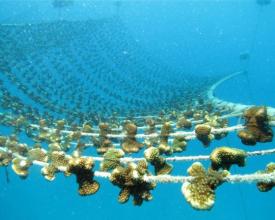
Sauveteurs de récifs : Restaurer les services écosystémiques des récifs coralliens
Reef Rescuers a mis en œuvre le tout premier projet de restauration de récifs à grande échelle en utilisant le "jardinage corallien". Ce projet a consisté à collecter plus de 40 000 petits morceaux de coraux sains sur des sites ayant survécu à un épisode de blanchiment, à les élever dans des pépinières sous-marines et à les transplanter sur un site dégradé de 5 300 mètres carrés dans la réserve spéciale de l'île Cousin, touchée par le blanchiment du corail. L'objectif est de renforcer la résilience des récifs coralliens endommagés par le blanchiment et d'améliorer les pêcheries, le tourisme et la protection côtière qui y sont associés.
Contexte
Défis à relever
Emplacement
Traiter
Résumé du processus
Blocs de construction
Évaluation de la vulnérabilité et plan des parties prenantes
Facteurs favorables
Leçon apprise
Développement des capacités pour la restauration des récifs coralliens
Facteurs favorables
Leçon apprise
Boîte à outils pour la restauration des récifs coralliens
Facteurs favorables
Leçon apprise
Impacts
- 5 300 mètres carrés de nouveaux récifs composés de 18 espèces de coraux ont été plantés dans la zone marine protégée de la réserve spéciale de l'île Cousin, achevée en juin 2014 et à ce jour saine, fonctionnelle et résistante au blanchiment - 41 praticiens de 11 pays ont été exposés aux techniques de restauration des récifs par un travail "sur le terrain" en tant que volontaires jusqu'à 3 mois in situ, et 8 experts ont à ce jour été formellement formés grâce à un programme de formation à temps plein de 6 semaines en salle de classe et sur le terrain. - Un suivi récent a montré une augmentation de 300 % des espèces de poissons et de 500 % du nombre de poissons dans le nouveau récif par rapport au site de contrôle dégradé.








